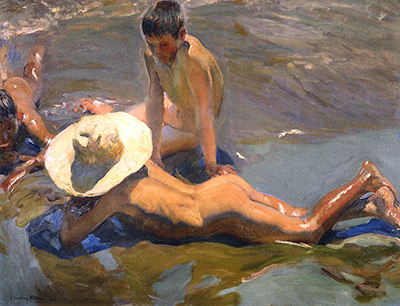Boys on the Beach is an oil on canvas painting by Joaquin Sorolla created in Spain. It was probably painted in 1909 since this is when Rafael Doménech reproduced the image in a book, although the painting is dated 1910.
Another reason for dating it to 1909 is that it is known Sorolla was in his native town of Valencia from June to September of that year and this is where the painting is set. The themes of children in water is one which crops up regularly in Sorolla's work, starting with his 1899 painting Sad Legacy which portrayed children suffering from Polio at the seaside. Painted in the impressionist style, the painting features three naked boys lying in the shallows of the sea. The theme of nude children enjoying the sun is one that had interested a number of other painters including John Singer Sargent, Mariano Fortuny, and Ignacio Pinazo, three painters Sorolla is known to have admired. There are some similarities in style with the painting focussed on the water's edge without featuring the horizon.
However, Sorolla's painting enjoys greater movement, conjuring up the action of the waves and the reflection of the sunlight on the children's bodies. With many of his paintings depicting the scenery and people of Spain illuminated by the bright Mediterranean sun reflected off the sea, it is unsurprising that Sorolla gained the epithet of the Spanish Master of Light. Boys on the Beach was painted from life. Sorolla had previously completed a number of drawings of children in reclining positions but none which can be directly attributed as preparation for this painting. In the foreground of the picture is a fair-haired, pale-skinned boy, drawing the eye into the darker bodies and hair of the other two children.
The middle boy is facing the first child, the smile on his face conveying the sense of joy at that moment. The purple, blue and turquoise paint strokes around the children show the ripples of the water, while the wetness of the skin, particularly of the furthest boy, faithfully protrays the intensity of the Spanish sun. Although clearly an impressionist painting, there are clear differences in styles between Sorolla and the French masters of the movement in the sharp brushstrokes and the realism displayed in the subject. In 1919 Sorolla donated the painting to the Spanish Museum of Contemporary Art. It remained there until 1971 when it was moved to Museo Nacional del Prado in Madrid, where it remains to this day.




